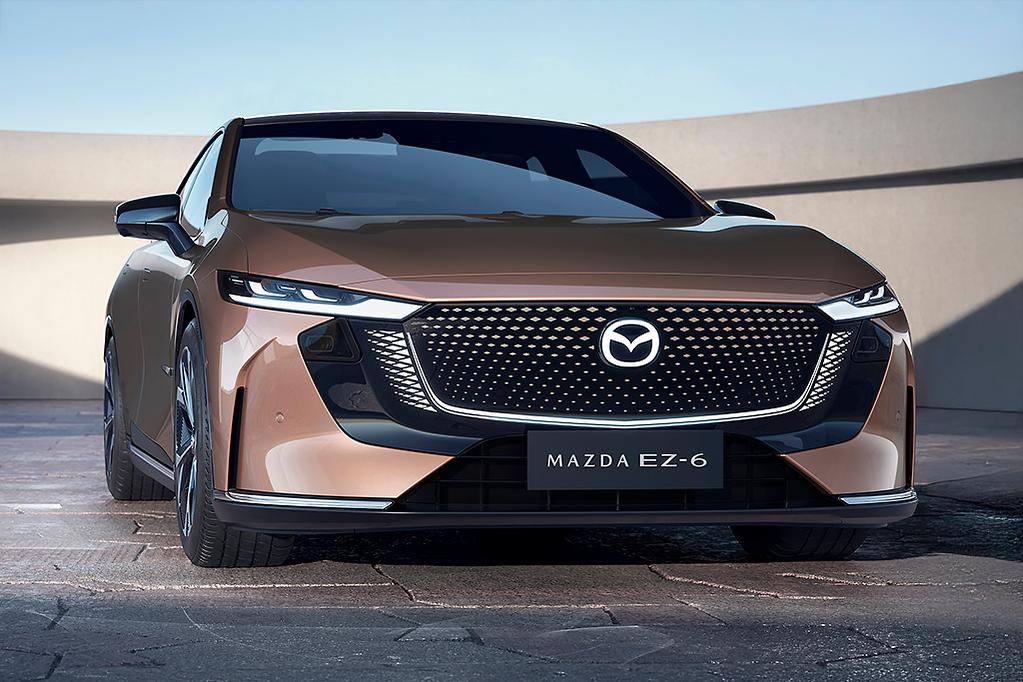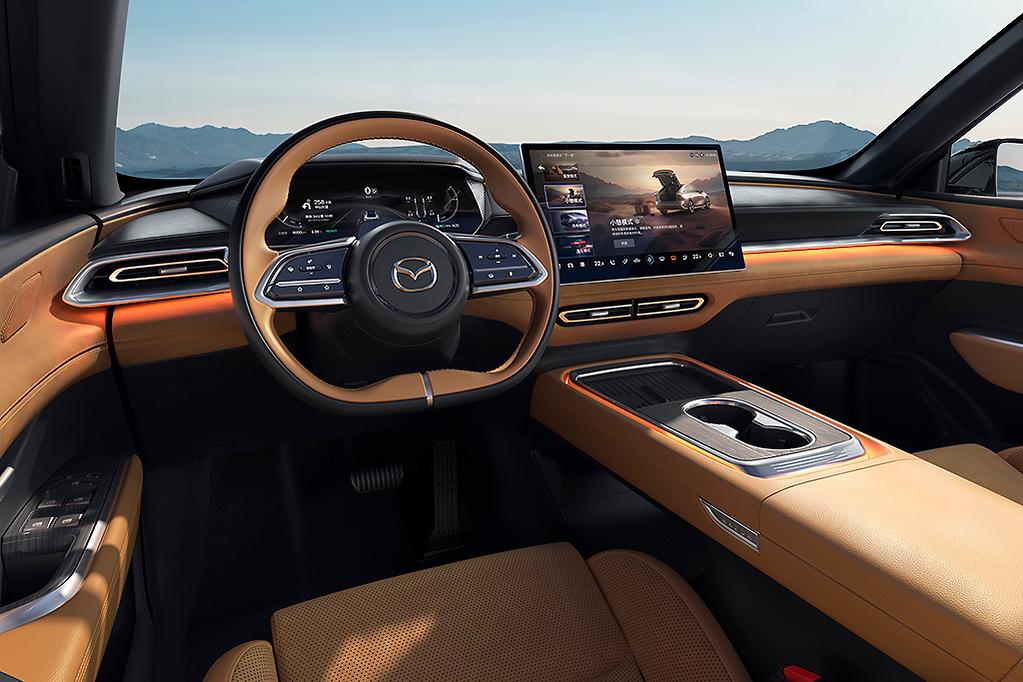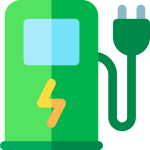
A camouflaged Mazda 6e – Mazda’s first electric liftback – has been sighted on Sydney roads in right-hand drive (RHD) form, reinforcing expectations that the model will arrive in Australia in the near future. The vehicle, photographed negotiating a suburban roundabout, follows a previous sighting in Melbourne and suggests Mazda is carrying out final development work tailored to Australia’s driving environment and climate.
Why the sighting matters
- RHD testing on local roads is a strong indicator that Mazda intends to bring the 6e to Australia rather than limit the model to left‑hand drive markets.
- The 6e would be Mazda Australia’s first model built in China – a notable change in sourcing strategy for a marque long associated with Japanese production.
- Repeated local testing points to final software calibration and drivetrain validation for Australian conditions, from urban traffic to long regional runs.
Where the 6e sits in Mazda’s portfolio
The 6e (sold as the EZ‑6 in China) effectively carries the torch for the discontinued Mazda 6 petrol sedan, but reimagined as an electric liftback. It’s built on the Changan EPA1 architecture – shared with vehicles such as the Deepal L07 and S07 – developed through Mazda’s joint venture with Changan Automobile. If launched here, the 6e will mark Mazda’s transition to a broader EV line-up based on alliance-built platforms while the company readies its own dedicated EV architecture, currently planned for 2027.
Powertrain, range and charging – what to expect
European-spec models provide the clearest public preview of the 6e’s likely technical offering in Australia. Mazda’s approach leans towards rear-wheel‑drive layouts and two battery options that balance range, charging performance and cost:
- Standard battery (LFP): 68.8 kWh, roughly 479 km WLTP range, 190 kW power output, up to about 165 kW DC charging.
- Extended battery (NMC): 80 kWh, roughly 552 km WLTP range, around 180 kW power output, up to about 90 kW DC charging.
These figures position the 6e competitively against established EV contenders in Australia, such as the Tesla Model 3 and Polestar 2. The LFP chemistry offers cost and longevity advantages and supports faster peak DC charging, while the higher‑capacity NMC pack targets maximum driving range – a useful differentiator for Australian buyers who regularly undertake long-distance travel.
Practical implications for Australian drivers
- Long-distance ability: WLTP ranges above 480 km (standard) and 550 km (extended) could make the 6e a practical choice for regional travel, provided drivers can access high-power public chargers on major routes.
- Charging landscape: Australia’s public high‑power charging network – run by operators such as Chargefox and Evie – will be important for the 6e’s real-world usability. The LFP variant’s higher peak DC capability should shorten charging stops where ultra-rapid chargers are available.
- Climate and depth of testing: Local RHD testing indicates Mazda is tuning thermal management and software for Australia’s varied climates, from temperate coastal conditions to hotter inland environments.
Equipment, interior and positioning
European trim lines (Takumi and Takumi Plus) suggest Mazda is aiming for a premium feel in the segment, with features including:
- 19-inch alloy wheels and a panoramic glass roof
- A 14.6-inch infotainment touchscreen alongside a 10.2-inch digital instrument cluster
- Heated, ventilated and power-adjustable front seats
While Australian trim and option lists are yet to be confirmed, the level of standard equipment shown overseas suggests Mazda will position the 6e as a direct challenger to mid‑to‑upper tier EV sedans and liftbacks – competing on style, interior quality and driving dynamics rather than purely on price.

Market strategy and Mazda’s EV roadmap
Mazda Australia managing director Vinesh Bhindi has indicated the company is “building a business case” for the 6e locally. Notably, Mazda appears focused on bringing the vehicle here only in fully electric form – the range-extended hybrid offered in China is reportedly not being considered for Australia.
Beyond the 6e, Mazda has signalled further EV expansion:
- Two additional Changan‑co‑developed EVs are expected between 2028 and 2030.
- Mazda’s first dedicated EV platform is slated to debut in 2027, which should underpin future models engineered from the ground up for electric powertrains.
Timing and availability in Australia
Although Mazda Australia has not yet issued a formal launch date or confirmed pricing, the presence of RHD test cars and the confirmed production of RHD units overseas make a local release increasingly likely. The 6e’s global rollout includes markets such as Thailand and the UK, and those launches provide a reference point for expected specifications and equipment. Australian availability will ultimately depend on Mazda’s local business case, regulatory approvals and logistics.
What this means for buyers and the broader market
- Consumer choice: The 6e would broaden mid‑size EV options in Australia, appealing to buyers who favour a traditional sedan/liftback silhouette with a focus on driving refinement.
- Competitive pressure: A well‑priced, well-equipped 6e could intensify competition for the Tesla Model 3, Polestar 2 and other premium EVs, potentially influencing pricing and incentives.
- Perception of China‑built vehicles: Mazda’s move to source this model from China may prompt discussion among Australian buyers about build origin, warranty support and resale values – all areas the brand will need to manage through warranty offerings, aftersales support and public communication.
Conclusion
The sighting of a right‑hand drive Mazda 6e in Sydney is more than a photography opportunity: it signals Mazda’s tangible progress toward bringing its first electric liftback to Australia. With competitive range estimates, substantive equipment levels and ongoing local testing, the 6e could emerge as a credible entrant in the mid‑size EV segment. As Mazda balances Chinese-built sourcing with a plan for a dedicated EV platform from 2027, Australian buyers can expect an expanding and more diverse Mazda EV range in the coming years. For now, the key questions remain pricing, exact local specification and the timing of a formal launch – all factors that will determine the 6e’s impact on Australia’s rapidly evolving EV market.
FAQs
When will the Mazda 6e be available in Australia?
Mazda Australia has not announced an official launch date. Right‑hand drive testing in Australia and confirmed RHD production overseas make a local release likely in the near term, with industry expectations pointing to a possible 2025-2026 introduction depending on Mazda’s commercial decisions.
What range can drivers expect from the 6e?
European specifications list two WLTP figures: about 479 km for the standard LFP battery (68.8 kWh) and about 552 km for the extended NMC battery (80 kWh). Real‑world range will vary with driving conditions, climate and use of heating/cooling systems.
How fast can the 6e charge on public chargers?
Charging capability differs by battery option: the standard LFP pack is reported to accept around 165 kW DC peak charging, while the extended NMC pack is listed around 90 kW peak. Access to ultra‑rapid public chargers will influence charging times and long‑distance usability.
Will Mazda Australia offer a hybrid version?
Mazda has indicated it is focusing on a fully electric 6e for markets outside China. The range‑extended hybrid offered in China is not expected to be offered in Australia.
Is the Mazda 6e built in China – and does that matter?
Yes – the 6e is manufactured in China as part of Mazda’s joint development with Changan. While some Australian buyers scrutinise country of manufacture, factors such as warranty terms, local servicing capability and overall build quality are typically more important determinants of ownership satisfaction.
About EV Evolution
EV Evolution is the leading online platform dedicated to Australian electric vehicle owners and enthusiasts. We foster a vibrant community, delivering essential EV news and insights, and enhancing user engagement through our innovative, AI-powered chatbot for dynamic discussions. Our mission is to empower Australian electric vehicle owners and enthusiasts by fostering a vibrant, AI-driven online community that connects, informs, and advances the nation’s electric vehicle landscape.




